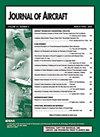DPW-7:不同雷诺数下常用研究模型的稳态和非稳态计算
IF 2.1
3区 工程技术
Q2 ENGINEERING, AEROSPACE
引用次数: 0
摘要
本文介绍了ONERA为第七届AIAA阻力预测研讨会进行的数值计算。通过引入高达30的雷诺数 百万次接近飞行条件,超过设计点的升力水平更大,以及时间精确的模拟,这一新的会议使之前的研究得以扩展。通用研究模型飞机构型已在其学术翼身版本中得到考虑,并在本工作中使用点匹配结构网格进行计算。已经使用了ONERA仙后座软件、elsA求解器和FFDπ远场阻力代码。网格收敛研究表明,压力-阻力变化比巡航升力系数下获得的变化更大,但增加雷诺数似乎会减少这种趋势。然后,对升力、阻力和力矩极点的攻角-扫掠研究提供了机会,可以使用二次本构关系方法(QCR-2000)评估不同的数值设置,如Spalart–Allmaras和[公式:见正文]剪切应力传输湍流模型,并讨论计算流体动力学结果与风洞数据之间的比较。关于雷诺数的增加,减阻的主要部分似乎来自摩擦([公式:见正文])和粘性压力阻力([公式,见正文]])分量。雷诺数变化引起的俯仰力矩增量的预测仍需显著改进。最后,对于4.00度以上的攻角,通过使用非定常雷诺平均Navier-Stokes计算,观察并分析了非定常抖振现象。本文章由计算机程序翻译,如有差异,请以英文原文为准。
DPW-7: Steady and Unsteady Computations of the Common Research Model at Different Reynolds Numbers
This article presents the numerical computations performed at ONERA for the Seventh AIAA Drag Prediction Workshop. By introducing Reynolds numbers up to 30 million closer to the flight conditions, greater lift levels beyond the design point, and time-accurate simulations, this new session has allowed the previous studies to be extended. The Common Research Model aircraft configuration has been considered in its academic wing-body version and calculated in this work with point-matched structured grids. The ONERA Cassiopee software as well as the elsA solver and the FFDπ far-field drag code have been used. The grid convergence study has shown larger pressure drag variations than what was obtained at the cruise lift coefficient, but increasing the Reynolds number seems to reduce this trend. Then, the angle-of-attack sweep study with the lift, drag, and moment polars has given the opportunity to assess different numerical settings such as the Spalart–Allmaras and [Formula: see text] shear stress transport turbulence models with the quadratic constitutive relation approach (QCR-2000) and to discuss the comparison between computational fluid dynamics results and wind-tunnel data. Concerning the Reynolds number increase, it has appeared that the main part of drag reduction comes from the friction ([Formula: see text]) and viscous pressure drag ([Formula: see text]) components. The prediction of pitching moment increments due to Reynolds number variations still needs to be significantly improved. Finally, for an angle of attack above 4.00 deg, by the use of unsteady Reynolds-averaged Navier–Stokes computations, an unsteady buffet phenomenon has been observed and analyzed.
求助全文
通过发布文献求助,成功后即可免费获取论文全文。
去求助
来源期刊

Journal of Aircraft
工程技术-工程:宇航
CiteScore
4.50
自引率
31.80%
发文量
141
审稿时长
6 months
期刊介绍:
This Journal is devoted to the advancement of the applied science and technology of airborne flight through the dissemination of original archival papers describing significant advances in aircraft, the operation of aircraft, and applications of aircraft technology to other fields. The Journal publishes qualified papers on aircraft systems, air transportation, air traffic management, and multidisciplinary design optimization of aircraft, flight mechanics, flight and ground testing, applied computational fluid dynamics, flight safety, weather and noise hazards, human factors, airport design, airline operations, application of computers to aircraft including artificial intelligence/expert systems, production methods, engineering economic analyses, affordability, reliability, maintainability, and logistics support, integration of propulsion and control systems into aircraft design and operations, aircraft aerodynamics (including unsteady aerodynamics), structural design/dynamics , aeroelasticity, and aeroacoustics. It publishes papers on general aviation, military and civilian aircraft, UAV, STOL and V/STOL, subsonic, supersonic, transonic, and hypersonic aircraft. Papers are sought which comprehensively survey results of recent technical work with emphasis on aircraft technology application.
 求助内容:
求助内容: 应助结果提醒方式:
应助结果提醒方式:


